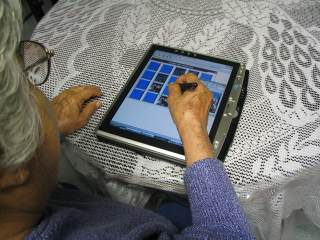|
Home
Conference Overview
Conference Committee
Exhibiting & Recruiting
Sponsoring
About Portland

Our Sponsors

Conference Program Conference Program
Presenting at CHI
Exhibitors
Recruiters
Registration
Housing
Student Volunteers

Call For Participation Introduction
Submissions Overview
Archived CFPs
All submissions closed



 | Student Design Competition Results Co-Chairs Elizabeth Churchill, Palo Alto Research Center, USA
Jon Sykes, Glasgow Caledonian University, UK
Twenty-six teams engaged in the CHI 2005 Student Design Competition’s challenge to design a tool, application or service for elder companionship. Based on reviewers’ comments, 11 were selected to present posters at CHI in Portland, Oregon. Four judges from the CHI community (acknowledged below) were invited to read the posters and question the students on their design solutions, and 4 teams were selected to give a spoken presentation. Judges commented and allocated points for not only the solution but also the design process that students engaged on. A close competition, there was a winning team and two teams tied in second place. The short-listed and winning teams were:
Winning Team:
mPath
Shweta Aneja, Kevin Makice, Apurva Pangam, Matt Weldon, Indiana University, USA As the “baby-boomer” generation approaches retirement, the number of senior citizens residing in the United States is due to increase significantly. Issues involving seniors are likely to rise to the forefront of national consciousness. A primary concern for this population is the loss of companionship, which can contribute to isolation, depression, and decreased socialization. Using an iterative design process, a concept for a fee-based data management service is proposed to combat isolation among seniors. mPath works with administrators of assisted-living facilities to oversee an ad-hoc volunteer network. Interacting with residents, these volunteers assess social relationships and emotional reactions, quantifying for the computer their qualitative observations. In turn, the system examines data over time to isolate anomalies, highlight trends and anticipate future responses. Administrators act upon that information. The overall effect is to increase the social well being of seniors in an unobtrusive manner.
Runners Up, joint second place: Calafia
Pedro Santana, Marcela Rodriguez, Luis Castro, Angel Andrade, CICESE, Mexico; Victor Gonzalez, University of California, USA
Supporting Emotional Ties among Mexican Elders and Their Families Living Abroad
Our design aims to support the maintenance of emotional ties between Mexican elders and their families living abroad. Based on interviews and evaluation of prototypes with elders and their families, we envisioned and designed a system called "The Family Newspaper". The system facilitates the exchange of pictures, recipes, local news and other day-to-day information. It also includes a photo-based memory game intended to delay the cognitive decline experienced by elders as they grow older. In order to make easier its use for elders the system is based on Tablet-PC technology, however it can be accessed by family members through any web browser.

Pollen
Payaal Patel, Stefanie Danhope-Smith, The Savannah College of Art and Design, USA
One of the most trying aspects of growing old is the loss of loved ones. Older people often experience depression as a result of this reality. Without regular contact from friends and family to amend this loneliness, a gap may exist in the individual’s social welfare. Through a unique combination of Industrial Design and Interaction Design methods, we have formed a process that allows us to explore the contextual background of a problem as well as a physical product solution. By using this process, we were able to create Pollen, an affordable product that provides companionship through the exchange of meaningful artifacts.
Fourth Place:
geriComp
Chun-Yi Chen, Marina Kobayashi, Lui Min Oh, Carnegie Mellon University, USA We engaged the elderly extensively throughout our iterative design process - research, conceptualization, and evaluation. Our findings along the way cumulate into a solution that reflects an empathy toward the real needs of many elderly today. It consists of a wearable and stationary device that will allow the elderly to 1) record events through pictures and audio for sharing, 2) gather artifacts of their past such as photographs into a multimedia slideshow format for sharing with others, and 3) allow friends and family to be aware of the elderly person's location for safety purposes.
Short listed teams:
Blu Flavoured Rabbits
Farilee Mintz, Timothy Sherwood, Miroslava Vomela, George Mason University, USA The Voice Intelligent Reciprocating Gemütlich Orator (VIRGO) was developed from perceptions of companionship held by persons 65 years of age and older. The knowledge granted from ethnographic interaction with segments of the target population was applied toward the creation of a device. VIRGO is expected to fulfill various companionship needs derived from user-centered research, expert advice and those of the sponsor. Important findings from studies include the need for activity to continue as a matter of over all health and as a management tool for recovery from a loss. Also, it appears that in some cases the need for readily available health information is not necessarily welcome and in other cases it is very important. Echoes
Sidharth Saxena, Joshua Evnin, Justin Donaldson, Indiana University, USA
By encouraging deeper casual social interactions through games and sharing of personal memories and their tangible artifacts the TeleTable and Pitara can bring about emotional engagement, thereby encouraging and strengthening human-human companionship. Furthermore, by supporting intuitive and accessible methods for organizing and composing digital media, the TeleTable can help seniors to utilize the potential of new communication technologies in their interactions with family and friends. For more information, please visit http://design.informatics.indiana.edu/echoes
 Homie
Simone Kriglstein, Gunter Wallner, Vienna University of Technology, Austria
HOMIE: An Artificial Companion for Elderly People
Homie is an artificial companion for elderly people. We emphasized on the emotional investment of elderly people. We believe that emotions are a key to form a relationship. Furthermore, Homie facilitates health and happiness, which are the two things elderly people care most. For more information, see http://homie.enomisk.net. KRJN
Jacqueline Baur, Kristy Streefkerk, Ryan Varick, Indiana University, USA
The senior population is a broad, diverse demographic that it is often overlooked by traditional markets, particularly in the United States. In addition, seniors commonly experience feelings of isolation, abandonment and loneliness. We sought to examine the sources of depression in the elderly and to explore human-centered technological solutions. We then proposed a system of refrigerator-based technologies designed to foster self-reliance and connectedness among seniors.
Meeteetse
Kynthia Brunette, Matthew Eisenstadt, Erink Pukinskis, William Ryan, Indiana University, USA This paper introduces Meeteetse, a set of technologies designed to facilitate social well-being through place attachment. Meeteetse builds a connection between individual homes and a local community center, a connection that is designed to encourage active involvement in community events and create a support network for those who might otherwise be isolated by the effects of old age. The design consists of several parts that work together to build this connection. A location-aware digital camera and a large public display are integrated into the community center to strengthen shared identity. A touch-screen scheduling device and a digital picture frame create a tangible community presence in seniors’ homes. Together, these components enhance social well-being and lower the barrier for participation in the community. PAL
Sara Lennon, Grainne O'Brien, Elaine Hollywood, Dun Laoghaire Institute of Art, Design and Technology, Ireland Short Description: This project illustrates the creation of an interactive entertainment system; PAL (Program Alleviating Loneliness.) The purpose of PAL is to provide artificial companionship to support the social well-being of elderly homebound persons living alone above the age of 65 years. PAL allows the elderly to listen to music, reminisce, complete mind puzzles, send emails and chat with other owners of the device. PAL also provides a fully reliable source of emergency contact. PAL is intended for the elderly homebound persons of today with its simplistic design.
Remember When
Nuala Dwyer, Karen Ni Bhrian, Niamh Capriani, Kim Harrison, Dun Laoghaire Institute of Art, Design and Technology, Ireland Short Description: The design criterion was to design a device that alleviates loneliness among the elderly through artificial companionship. However we felt that an emotion such as loneliness cannot be combated with technology alone and the key to alleviating loneliness is through human companionship and interaction with others. We envision a piece of technology entitled Remember When to act as a mediator to bring elderly people together to create bonds and in turn help to alleviate loneliness. Remember When is an interactive laptop style device which invests reminiscence therapy with technology aiming to improve the well being of elderly people.
|